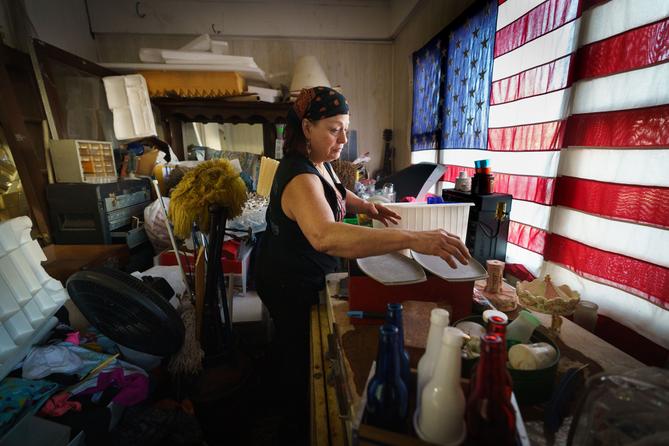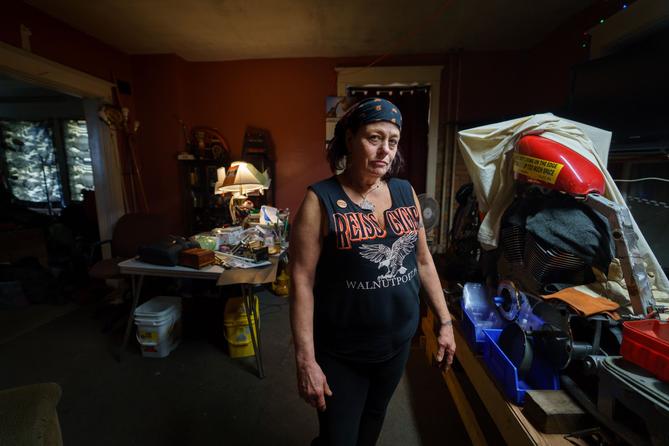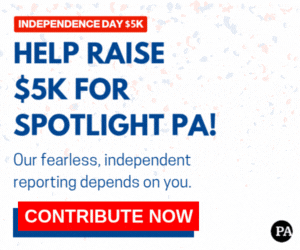Spotlight PA is an independent, non-partisan newsroom powered by The Philadelphia Inquirer in partnership with PennLive/The Patriot-News, TribLIVE/Pittsburgh Tribune-Review, and WITF Public Media. Sign up for our free newsletters.
Sandra Huffman was cleaning St. Luke’s hospital in Quakertown, gloved and maskless, when she got sick last March. It felt as though a film of spiderwebs had caked her throat, she said. At 54, she was sleeping upright in bed, breathing through a borrowed nebulizer, and drinking an old family remedy of fat Spanish onions congealed in sugar.
She sold her ’86 Chevy Mallard RV, then her mother’s gold jewelry. By late summer she was collecting cans for scrap metal. Huffman did not know that a federal Pandemic Unemployment Assistance program, administered by the state, would provide money for people like her until October.
“Trying to get a job without a vehicle in rural PA, it is scary,” Huffman said. “We just basically sold or traded everything we owned. There wasn’t a lot of information that filtered down to us. That’s how we got by.”
Pandemic unemployment benefits were a lifeline to Huffman and more than 400,000 other Pennsylvanians who don’t qualify for traditional unemployment. But payments stalled the day after Christmas because former President Donald Trump delayed their extension. Then, Huffman said, her claim disappeared from the state’s unemployment computer portal — a system that dates back to 1968.
Since then, it’s been a long and painful January for Huffman and those like her.
For a month, Pennsylvanians have been living without that support — a minimum $195 a week. State officials blame the lapse in the CARES Act and the fact that the federal government did not send instructions to the state on how to administer the new law until Jan. 11. It wasn’t until Jan. 22 that the state Department of Labor and Industry began accepting and paying out those claims. But claimants are still facing numerous bureaucratic hurdles, and many have still not received payment for all of the weeks they missed.
“Whatever I’ve ever done in my life, I count on when I open my refrigerator the light goes on,” Huffman said. “I need responsible people to take care of that stuff.”
Lawmakers, experts, and union leaders agree that Pennsylvania’s unemployment compensation system needs massive overhauls, but that is unlikely to be enough to address the current unemployment crisis, if it happens at all. True relief will only begin when the virus is under control, economists say.
Over the last several months, the state Labor Department has increased staff by 165% as stressed employees worked overtime, but it’s still struggling. More than 83,000 new claims were filed last week alone, with over 67,000 people contacting the department for help, according to state statistics.
“I am very empathetic,” acting Labor Secretary Jennifer Berrier said during a news conference Tuesday, admitting problems have persisted in the claims system and staffing levels. “We realize people are suffering and we want to help.”
Between federal relief and unemployment compensation, the department has had to process more than 5 million claims since the pandemic began. At the height of the unemployment crisis at the start of May, it was receiving roughly one million claims each week, as Gov. Tom Wolf temporarily shut all non-essential businesses. This rush was more than three times the amount filed during the peak of the Great Recession in 2009. Phone lines jammed and the website for the Department of Labor and Industry crashed repeatedly as sick and economically strained Pennsylvanians scrambled to access benefits.
Rep. Timothy O’Neal, (R., Washington), who called for an investigation into the agency in June but failed to gain support from House leadership, said the agency was slow to respond, and constituents, desperate for help, inundated him and other lawmakers. One woman said she resorted to feeding her family with dog food.
“The department, with their antiquated system, wasn’t ready. They weren’t ready for any stress on the system, especially the magnitude we ended up seeing,” O’Neal said. “This safety net throughout the Commonwealth was simply failing.”
Feeling the strain
The Department of Labor and Industry has long been hamstrung by funding problems and a system that’s over 50 years old. In December 2016, the agency laid off 500 staffers and closed several unemployment centers. The following April, then-Auditor General Eugene DePasquale said the agency failed to keep track of its finances while estimating it would need an additional $159 million over the next four years to keep the remaining operations running, update infrastructure, and address its state of “chaos.”
Since the pandemic hit in March, the agency has added 775 new workers, though they say they are still under unrelenting stress after months of overtime. The department has also delayed implementing a new computer system, meant to launch first in 2019 and then last October, for fear any glitch would further compound problems. Officials now say they hope to launch it this spring.
For Shawn Domenico, who has worked for the state Labor Department in Pittsburgh since 2010, processing so many claims — especially for people that might not qualify despite their evident need — has made his work devastating.
He saw the department grapple with the fallout of the Great Recession and the funding deficit in 2017. But nothing has compared to 2020, he said.
Domenico took a leave in September to work for his union, advocating for labor staff. The prior months left the 46-year-old feeling broken, physically and mentally. He had been processing claims up to 12 hours a day, 6 or 7 days a week. He gained weight and said he couldn’t think straight.
“And it still wasn’t enough,” he said. “You feel guilty. No matter how much you worked the backlog got bigger, the people you dealt with were waiting longer and longer and there was no way to fix it.”
In a Facebook support group for unemployed Pennsylvanians with 8,600 members, users have posted questions they have been unable to get answered by the Department of Labor. When someone does get through to the agency’s chatline, they post an urgent message in the forum to try to help several people get their questions answered at once.
They want to know how to get missing weeks of back pay, how to restart claims after being disqualified, and, most urgently, how to get through to someone.
“Call on Thursday or Friday,” some members suggest, or start at 7:55 a.m. and “just keep dialing.”
“I will pay someone to get on the phone,” one member wrote.

‘A triple whammy’
When the unemployment system was established in 1935 under the Social Security Act, it was a concept designed for male manufacturing workers, said Stephen Herzenberg, economist and executive director of Keystone Research Center.
“We need to take a harder look at our unemployment insurance system,” Herzenberg said.
Instead of creating a more robust framework to fund unemployment reserves, decades of policies made it more difficult to qualify for benefits. These decisions disproportionately harmed women and people of color who were already disenfranchised by a system not built for them, he said.
Traditional unemployment requires a certain level of earnings and consistent employment. Low wage and temporary workers, who are more frequently women and people of color, are often ineligible. As of last March, fewer than 40 percent of unemployed workers in Pennsylvania qualified for benefits, according to an analysis by the Pew Research Center.
In addition to applying through an unwelcoming system, women and people of color are also concentrated in the industries most impacted by the pandemic: they work in hospitality and retail, and high-risk workplaces like nursing homes.
While 3.9 percent of women were unemployed in Pennsylvania at the end of 2019, compared to 4.3 percent of men, that rate more than doubled to 9 percent by November of 2020, and 8.7 percent of men. At the peak of pandemic claims in May, more than 22 percent of women were unemployed compared to 19 percent of men.
Undocumented immigrant workers are subject to a third tier of harm, Herzenberg said, because they are excluded from government benefits altogether. As a result, “With respect to women and people of color, the pandemic brought with it what we call a triple whammy,” Herzenberg said.
Since November 2019, the state’s leisure and hospitality industry experienced the sharpest cuts, losing 172,200 jobs, more than 30 percent of the jobs lost, followed by education and health services. Finance and construction jobs experienced the smallest percent loss, at 2.5 percent of job loss or less.
Black workers in Pennsylvania were more than twice as likely to face joblessness than white workers as a result of the pandemic, and rates were nearly as high for Hispanic workers, according to an analysis by Pennsylvania State University researchers.
Those without a college or high school degree, and people with disabilities, also experienced much higher rates of unemployment, according to state data released in December.
“All those factors — of education, career, and access to infrastructure — studies have shown are associated with structural racism,” said Timothy Kelsey, a professor of agricultural economics at Penn State, who led the research. “We strongly suspect those issues underline the differences here.”
The privilege of working from home
As most businesses shut down last year, Latrinia Gaston, at 46, kept her job cleaning a PNC bank building and at a call center in Allegheny County, but work became a constant source of fear. People in the building contracted the coronavirus regularly, she said.
Daily, she felt, “just anxiety, just afraid,” she said. “You don’t want your kids to be impacted by nothing, you want to make sure they are safe.”
She stayed alert at work and kept six-feet from those around her, wearing a mask and goggles. Then in mid-December, she felt an unusual headache strain behind her eyes and tested positive for the coronavirus. Her husband, who also cleans on a night shift, tested positive, too.
Fatigued, nauseous, and short of breath, she cared for her husband and her son, Kane, who is 12 and has ADHD. To help him with his schoolwork, they’d put on gloves and talk through masks in the hallway.
ISS, the cleaning company she works for, paid for two weeks of sick leave and wouldn’t let her return to work without a negative test. But she tested positive again in the third week. Neither she nor her husband was paid, and she filed for unemployment.
Their mortgage was due and she needed groceries. She worried the headaches brought on by the virus might never go away.
“It’s a lot,” she said. “It’s more stress and anxiety than anything because we don’t have money coming in.”
Domenico, the claims officer, said there were so many people filing that he had little time to help or direct people whose claims were filed through the wrong program or did not qualify at all. Federal guidelines also continued to change the rules for how to process claims through various pandemic assistance programs.
He said the Labor Department staff feels that “if it goes on for much longer they aren’t going to be able to help people because the system just isn’t working.”
Over the summer, he biked to work at a building that abutted the Greater Pittsburgh Community Food Bank. He watched the long lines of people encircle the building, a need so great the food bank had to put down new gravel to expand the pathway where people could wait.
“You are exhausted and you are looking out at a world of people who can’t feed themselves and you can’t help them,” Domenico said. “You begin to wonder what is going on.”
The existing system failed to imagine the pandemic, he said.
Traditional unemployment insurance requires people to seek work at a time when governments are urging people to stay home. Some unemployed Pennsylvanians, union leaders, and economists like Herzenberg said the previous administrations, particularly at the federal level, have failed, and they hope the Biden administration takes a stronger approach.
At the state level, bills to eliminate the wage gap in Pennsylvania — where women make roughly 80 percent of a man’s salary, and women of color even less — have gone nowhere. Though senators who support these changes hope that, with new female lawmakers in the legislature, and Kim Ward (R., Westmoreland) leading the state Senate, these bills could gain more traction.
Rep. Joe Ciresi (D., Montgomery), who has also called for an investigation into the unemployment system, said the legislature needs to figure out what went wrong with the agency and how to help people move forward.
“These are our taxpayers,” Ciresi said. “We have an obligation to make sure these departments are well-funded and well-staffed and that is where the ball dropped.”
100% ESSENTIAL: Spotlight PA relies on funding from foundations and readers like you who are committed to accountability journalism that gets results. Become a member today at spotlightpa.org/donate.

